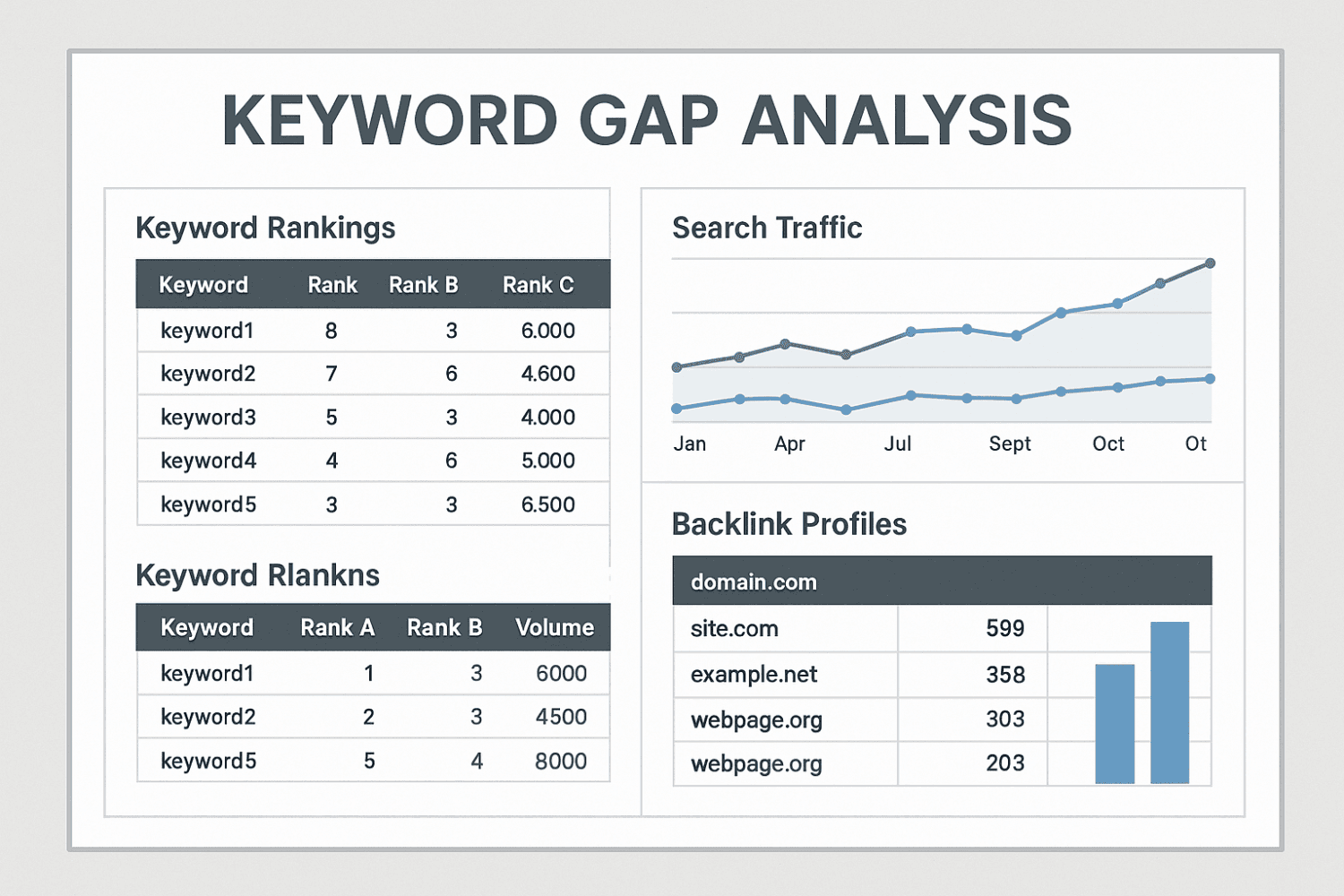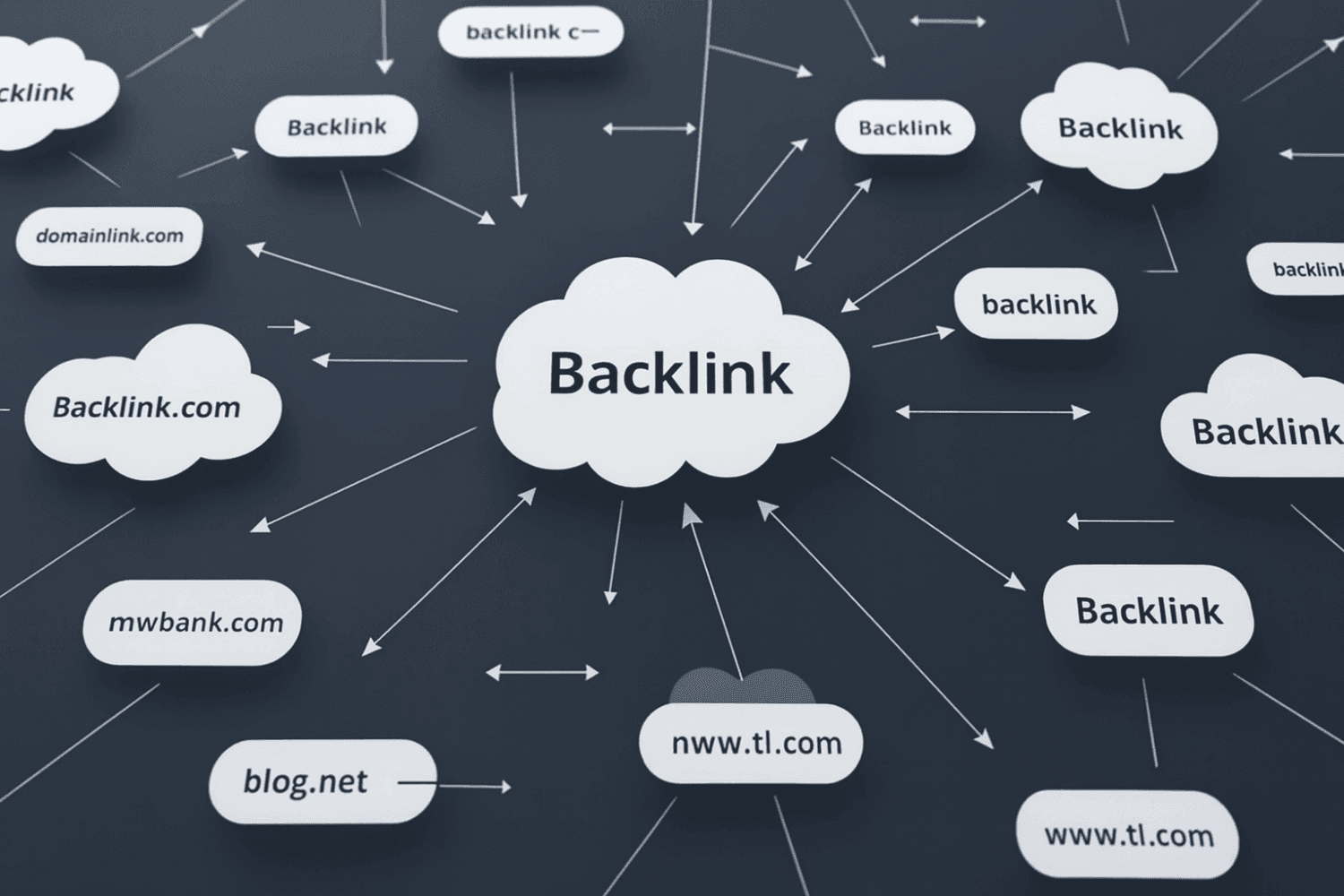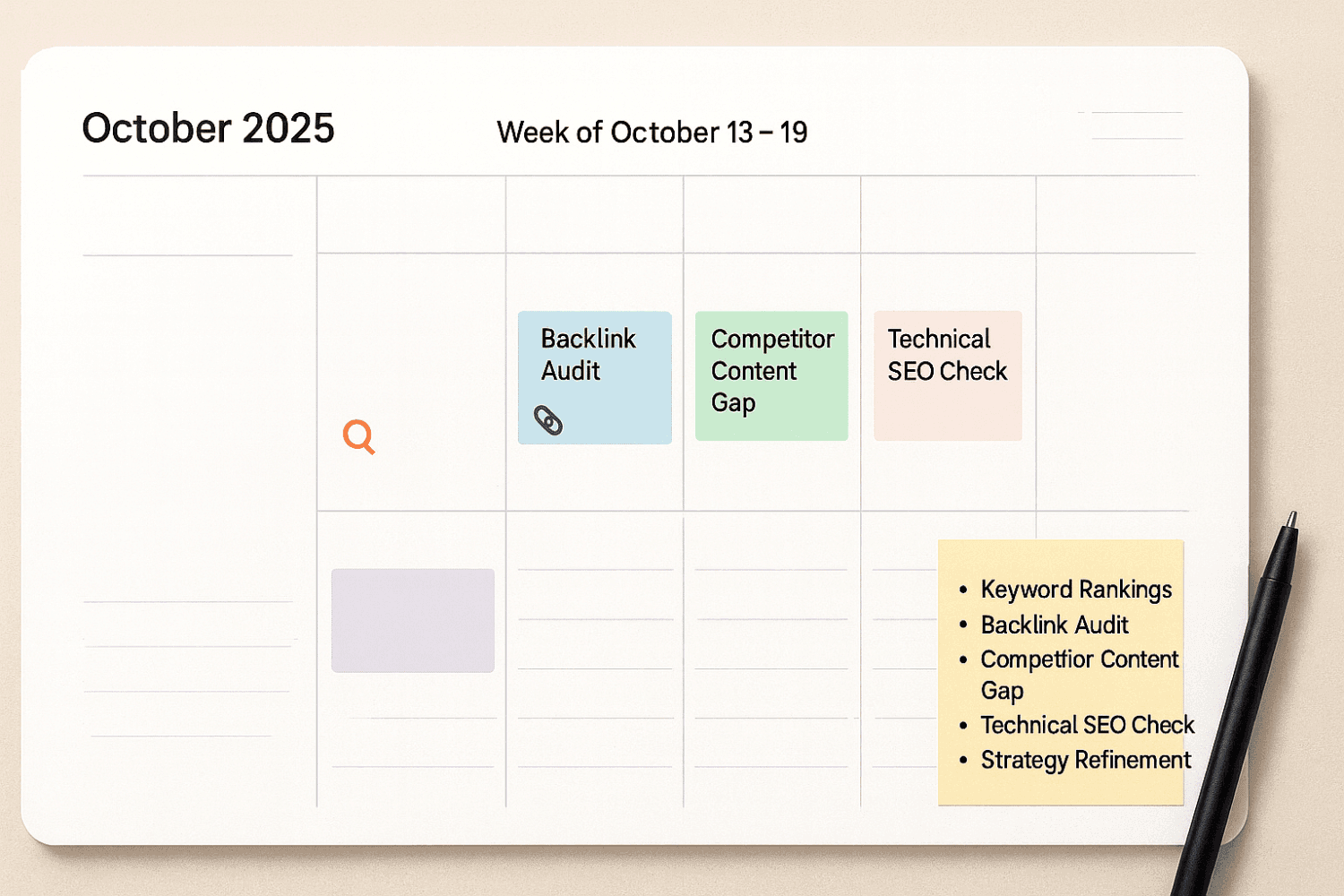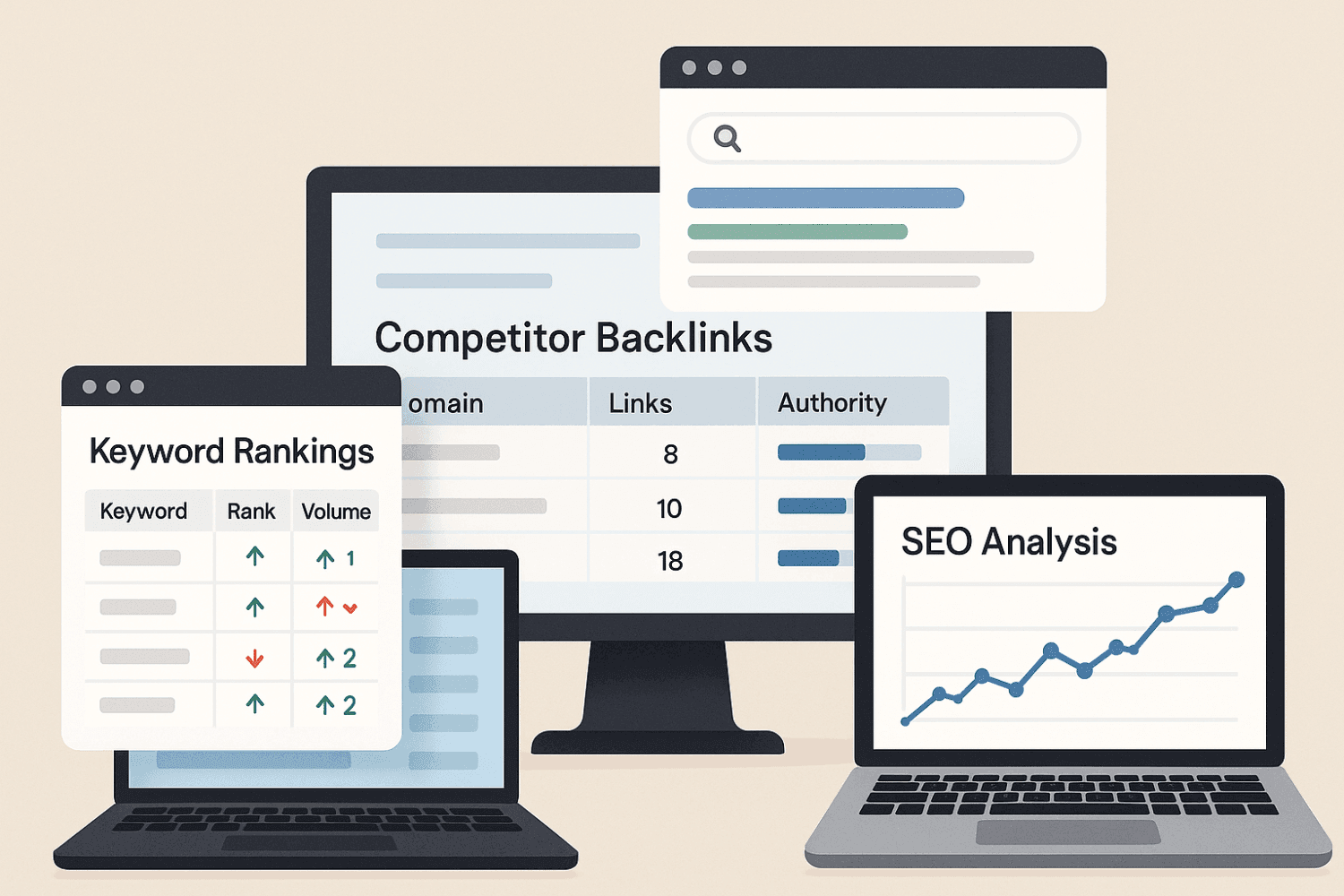How to Do Competitor Analysis for SEO: Complete Guide for 2024
Key Takeaways
- SEO competitor analysis reveals gaps in your strategy by studying rivals’ keyword targeting, content approaches, and backlink profiles to improve your search rankings
- Identify true SEO competitors through SERP research rather than assumptions – they may differ from your direct business competitors
- Focus on keyword gap analysis using tools like Semrush’s Keyword Gap tool to find keywords competitors rank for but you don’t
- Analyze competitor backlink profiles to discover link-building opportunities and strengthen your domain authority
- Conduct comprehensive competitor analysis every 3-6 months, with additional reviews after major Google algorithm updates
Your competitors are stealing traffic you could be capturing. While 90% of web pages get zero search traffic from Google, your rivals have cracked the code to dominate search engine results for keywords that should be driving customers to your door.
SEO competitor analysis isn’t about copying what others do—it’s about reverse-engineering their success to outrank them. By systematically studying how competitors rank, what keywords they target, and where they acquire links, you’ll uncover the gaps in your own strategy that are costing you visibility and revenue.
This guide breaks down the exact process top SEO professionals use to analyze competitors, find untapped opportunities, and build strategies that capture market share in search results. You’ll learn which tools deliver the most actionable insights and how to transform competitor intelligence into rankings that stick.
What is SEO Competitor Analysis?
SEO competitor analysis is the systematic process of identifying and studying websites that compete with you for visibility in search engine results, regardless of whether they’re direct business competitors. Unlike traditional competitive research that focuses on companies selling similar products, SEO competitor analysis examines any website that ranks for your target keywords or captures your potential search traffic.
The scope extends far beyond business rivals. Your SEO competitors might include news sites, educational institutions, forums, or completely different industries that happen to rank for relevant keywords. A local plumber’s SEO competitor could be a DIY blog that ranks for “how to fix leaky faucet”—not another plumbing company.
Key components of competitor analysis include analyzing keyword targeting strategies, content approaches, backlink profiles, and technical SEO factors. This comprehensive view reveals why certain sites achieve better search engine rankings and how you can adapt successful tactics for your own domain.
The ultimate goal is reverse-engineering what works. Instead of guessing which keywords to target or what content to create, you’re using data-driven insights from competitors who already prove what search engines reward with higher rankings.
Why SEO Competitor Analysis Matters for Your Business


Search traffic isn’t evenly distributed—it’s concentrated among websites that understand and execute what search engines value. Statistics show that 90% of web pages receive no organic search traffic, while top-ranking competitors capture the lion’s share of clicks and conversions from your target audience.
Understanding why rivals outrank you in search results transforms random SEO efforts into strategic advantages. Competitor analysis reveals the specific factors driving their success: the targeted keywords they prioritize, the content strategies that earn engagement, and the backlink profiles that signal authority to search engines.
The benefits extend beyond improved search rankings. By identifying content gaps and keyword opportunities your competitors miss, you can increase organic traffic, capture market share, and boost conversions from users actively searching for your solutions. Companies that regularly analyze competitors consistently outperform those flying blind.
Perhaps most importantly, competitor analysis provides market positioning insights that inform broader business strategy. You’ll understand which brands dominate different keyword categories, how user search intent varies across your industry, and where emerging threats or opportunities exist in the digital landscape.
Step-by-Step Guide to Conducting SEO Competitor Analysis
Identify Your True SEO Competitors
Start by abandoning assumptions about who your competitors actually are in search results. Your main business rival might not even rank for keywords that matter to your customers, while completely unexpected sites capture traffic you want.
Begin with manual SERP research for your most important target keywords. Search these terms in Google and document which websites consistently appear in the top 10 results across multiple queries. These domains are your true SEO competitors, regardless of their business model or industry focus.


Use SEO tools like Semrush’s Organic Research and Ahrefs to accelerate this process. Enter your domain to see which sites have overlapping keyword rankings with yours. The “Competitors” section reveals domains competing for the same search traffic, often uncovering competitors you wouldn’t identify through business-focused research alone.
Focus your analysis on 3-5 main competitors to avoid information overload. Prioritize sites that consistently outrank you for keywords with high search volume and commercial intent. These competing sites represent your biggest opportunities for capturing additional market share.
Perform Comprehensive Keyword Gap Analysis
Keyword gap analysis identifies specific terms your competitors rank for that you don’t—revealing proven opportunities where search engines already reward competitors with traffic. This targeted approach beats random keyword research because you’re analyzing keywords that demonstrably drive results.
Use Semrush’s Keyword Gap tool to compare your domain with up to 4 competitors simultaneously. The tool categorizes keywords into segments: “Missing” shows keywords where all competitors rank but you don’t, while “Untapped” reveals keywords where some competitors rank but not others.
Focus on the “Missing” keywords first, as these represent the clearest gaps in your strategy. Filter results by search volume and keyword difficulty to identify opportunities that match your domain’s authority level. High-volume, low-difficulty keywords offer the fastest wins.
Don’t ignore “Lost” keywords—terms you previously ranked for but competitors have now captured. These represent defensive opportunities where you can reclaim lost search traffic by updating existing content or rebuilding topical authority.
Track new keywords competitors have started targeting to understand their content direction. This intelligence helps you anticipate their strategy and potentially outrank them for emerging opportunities before they establish dominance.
Analyze Competitor Content Strategy
Content analysis reveals why competitors outrank you for shared keywords and uncovers content gaps you can exploit. Study the top ranking pages for keywords where competitors consistently beat your rankings, focusing on content depth, format, and search intent alignment.
Evaluate content effort levels across competing sites. Do they publish comprehensive guides while you offer basic pages? Are they creating video content, interactive tools, or detailed comparisons that provide more value to searchers? The winners typically invest more effort in user experience and comprehensive coverage.
Examine on-page SEO elements including title tags, meta descriptions, header structure, and internal linking patterns. Competitors ranking above you often optimize these elements more effectively for both search engines and user engagement. Note how they structure information and incorporate targeted keywords naturally.
Identify content gaps where competitors fail to serve user intent completely. Perhaps they rank for “best project management software” but don’t cover pricing comparisons or integration guides. These gaps become opportunities for your own content strategy to capture traffic they’re leaving on the table.
Study how competitors align content with different search intent types. Their informational content might target awareness-stage keywords, while transactional pages focus on conversion-ready searchers. Understanding this mapping helps you create more strategic content that serves the complete customer journey.
Evaluate Competitor Backlink Profiles
Backlink analysis reveals the authority sources that help competitors rank higher and identifies specific link-building opportunities for your own domain. Since backlinks remain a major ranking factor, understanding competitor link profiles is essential for developing effective SEO strategy.
Use Semrush’s Backlink Analytics and Backlink Gap tools to compare link profiles across competing domains. Focus on high-quality backlink sources—active, follow links from authoritative websites that demonstrate trust and relevance to search engines.
The Backlink Gap tool specifically shows referring domains that link to competitors but not to your site. These represent direct outreach opportunities where you already know the source is willing to link to your type of content or business. Filter results to focus on domains with high authority scores and relevant traffic.
Identify patterns in competitor backlink acquisition. Do they earn links through guest posting on industry blogs, resource page listings, or partnerships with complementary businesses? Understanding their link-building strategies helps you replicate successful approaches while avoiding tactics that haven’t proven effective.


Analyze the anchor text distribution in competitors backlinks to understand how they naturally acquire keyword-rich links. However, avoid over-optimizing your own anchor text—focus on earning diverse, natural link profiles that signal authority without triggering search engine penalties.
Look for broken link building opportunities by identifying high-quality sites that previously linked to competitors but now link to dead pages. These broken links represent immediate outreach opportunities where you can offer relevant replacement content.
Assess Technical SEO Performance
Technical factors often determine why competitors rank higher despite similar content quality or backlink profiles. Systematic technical analysis reveals performance gaps that could be limiting your search rankings and user experience.
Compare site speed and Core Web Vitals using Google PageSpeed Insights for your domain versus competitors. Sites that load faster and provide better user experience typically rank higher, especially after Google’s page experience update. Document specific performance gaps like image optimization, server response times, or JavaScript efficiency.
Evaluate mobile-friendliness across competing sites using Google’s Mobile-Friendly Test. With mobile-first indexing, competitors with superior mobile experiences often outrank desktop-optimized sites. Check how competitors handle responsive design, touch navigation, and mobile page speed.
Analyze URL structure and site architecture by exploring how competitors organize their web pages and internal links. Sites with clear hierarchies and logical internal linking often achieve better search engine rankings because they help search engines understand content relationships and distribute page authority effectively.
Review schema markup and structured data implementation across competitor sites. Competitors using rich snippets, FAQ markup, or product schema may capture more SERP real estate and click-through rates even when ranking in similar positions. Tools like Google’s Rich Results Test reveal which structured data competitors implement successfully.
Assess crawlability factors including XML sitemaps, robots.txt files, and redirect structures. Competitors with cleaner technical foundations often rank better because search engines can efficiently discover and index their content without encountering technical barriers.
Best Practices and Timing for SEO Competitor Analysis
Effective competitor analysis requires consistent timing and systematic approaches rather than sporadic efforts. Establish a regular schedule of comprehensive analysis every 3-6 months to capture evolving competitive landscapes and algorithm changes that shift search rankings.
Conduct immediate competitor analysis after major Google algorithm updates when search results experience significant fluctuations. Algorithm changes create opportunities to capture traffic from competitors who lose rankings while identifying new threats from sites that gain visibility. Monitor ranking changes for 2-4 weeks after updates to ensure data stability before drawing conclusions.
Trigger additional analysis during specific business situations: launching new websites, entering new markets, experiencing significant ranking drops, or observing unusual competitor behavior in search results. These events often require rapid competitive intelligence to understand changing dynamics and respond appropriately.
Use automated monitoring tools to track competitor changes between comprehensive analyses. Set up alerts for significant ranking movements, new content publication, or backlink acquisition by main competitors. This ongoing surveillance helps you react quickly to competitive threats or opportunities.


Document findings in actionable reports that connect competitor insights to specific strategy adjustments. Track which competitive intelligence leads to successful implementations and measure ROI from competitor-inspired tactics. This data justifies continued investment in competitive analysis and refines your approach over time.
Avoid the trap of constant reaction to every competitor move. Focus on systematic analysis that identifies patterns and strategic opportunities rather than tactical copying of individual actions. The goal is understanding why competitors succeed, not blindly mimicking their every move.
Essential Tools and Templates for Competitor Analysis
Professional SEO competitor analysis requires tools that automate data collection and provide comprehensive insights across multiple competitive factors. Semrush leads the category with integrated features for keyword gaps, backlink analysis, and content research in a single platform.
Ahrefs excels in backlink analysis and provides detailed insights into competitor link-building strategies. Their Site Explorer tool reveals referring domains, anchor text distribution, and historical backlink growth patterns. The Content Gap feature identifies keyword opportunities by comparing your content coverage against multiple competitors.
Moz Pro offers domain authority metrics and competitive intelligence through their Keyword Explorer and Link Explorer tools. Their SERP analysis features help understand why competitors rank for specific queries and what factors influence their search engine rankings.
Google Search Console provides free competitive insights through the Performance report, showing queries where your site appears alongside competitors. While limited compared to paid tools, it offers authentic search data directly from Google about your competitive positioning.
For technical analysis, use Google PageSpeed Insights, GTmetrix, and Core Web Vitals reports to benchmark site performance against competitors. These free tools reveal specific technical advantages or disadvantages that impact search rankings.
Create standardized templates using Semrush’s My Reports tool for consistent competitor analysis documentation. Customize reports to track specific metrics that matter to your business goals and schedule automated delivery to stakeholders who need regular competitive intelligence.


Consider enterprise solutions like seoClarity or BrightEdge for large-scale competitor monitoring across thousands of keywords and multiple markets. These platforms offer advanced features like predictive analytics and automated competitive alerts that scale beyond manual analysis capabilities.
Supplement tool data with manual research for context that automated systems miss. Review competitor websites directly to understand user experience, conversion optimization, and brand positioning factors that don’t appear in standard SEO metrics but influence search performance.
FAQ
How do I identify my true SEO competitors if they’re different from my business competitors?
Search your target keywords in Google and note which websites consistently appear in the top 10 results. These are your SEO competitors regardless of whether they sell similar products or services. Use tools like Semrush’s Organic Research to enter your domain and find websites with overlapping keyword rankings. Don’t assume your business competitors are your search competitors—a local restaurant might compete with food blogs for recipe keywords, not just other restaurants.
What’s the difference between keyword gap analysis and regular keyword research?
Keyword gap analysis specifically identifies keywords your competitors rank for that you don’t, revealing missed opportunities. Regular keyword research focuses on finding new keywords for your industry. Gap analysis is more targeted and shows proven keywords that already drive traffic to similar sites. It’s essentially reverse-engineering successful competitor strategies rather than starting from scratch with broad keyword discovery.
Should I focus on high-volume keywords or long-tail keywords when analyzing competitors?
Focus on search intent rather than just volume. Long-tail keywords (4+ words) often have lower competition and higher conversion rates, making them ideal for smaller sites. About 70% of Google searches are long-tail queries, so they represent significant opportunities even with lower individual search volumes. However, balance your strategy—pursue achievable long-tail wins while building authority for competitive high-volume terms over time.
How can I tell if a competitor’s backlink is worth pursuing for my own site?
Look for active, follow links from reputable sources like news sites, educational institutions (.edu), and industry-relevant websites. Use tools to filter out low-quality links and focus on domains with high authority scores. The linking site should be relevant to your industry and have real traffic. Avoid pursuing links from obvious link farms, expired domains, or sites with suspicious traffic patterns that could harm your rankings.
When should I conduct competitor analysis after Google algorithm updates?
Perform analysis within 2-4 weeks after major algorithm updates when rankings have stabilized. Algorithm changes can cause rapid shifts in search results, creating opportunities to capture lost traffic from competitors or identify why they’ve gained rankings. Don’t react immediately to post-update volatility—wait for the dust to settle, then analyze which competitors benefited or suffered to understand what factors the algorithm now prioritizes.




